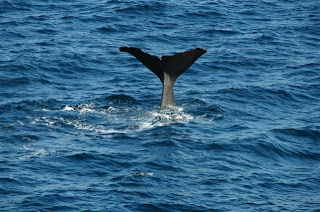fishing community that came to fame when it was so abruptly depopulated. The houses cling on the
rock knolls around the harbour.
After leaving Nyksund we headed for the Vesteralen Islands. To the West the island of Andoya there is a little rock called Bleikoya, which is home to tens of thousands of seabirds. Kittywakes, cormorants, alks, puffins, skuas and sea eagles were observed in great flocks turning around Bleikoya and feeding right offshore. However, because of the rocky approach, we couldn't get as close as at Runde.
So in the end we headed North-Northwest for the deep sea canyon off Andenes. This is where the male sperm whales dive to the sea floor, as deep as 1.000 metres below the surface, to catch squid, their preferred food. Their females prefer warmer temperatures of more than 15 degrees C and stay in the Carribbean, around the Azores, Madeira or off the Canary Islands. Shortly before reaching the canyon, the helmsman exclaimed "there she blows!".
We joined the whale-watching vessel from Andenes, MS Reine, which is equipped with an under- water microphone and via radio channel 16 were informed when strong clicks were heard, indicating a surfacing whale. We were verz lucky: our first whale surfaced right in front of us at 1 o'clock from our course, heading for us. After breathing about 30 times, the head of the whale came higher up, the animal took one last breath and then curved its back: "diving!". Then the fluke came up as the whale headed down for another vertical dive. Everybody took a photo of the tail, which for sperm whales is like a fingerprint. We will be able to identify the animal from the Andenes sperm whale catalogue.
The day ended in Bjarkoya, the settlement of the Viking Thore Hund, where we were met by real vikings and their families.






